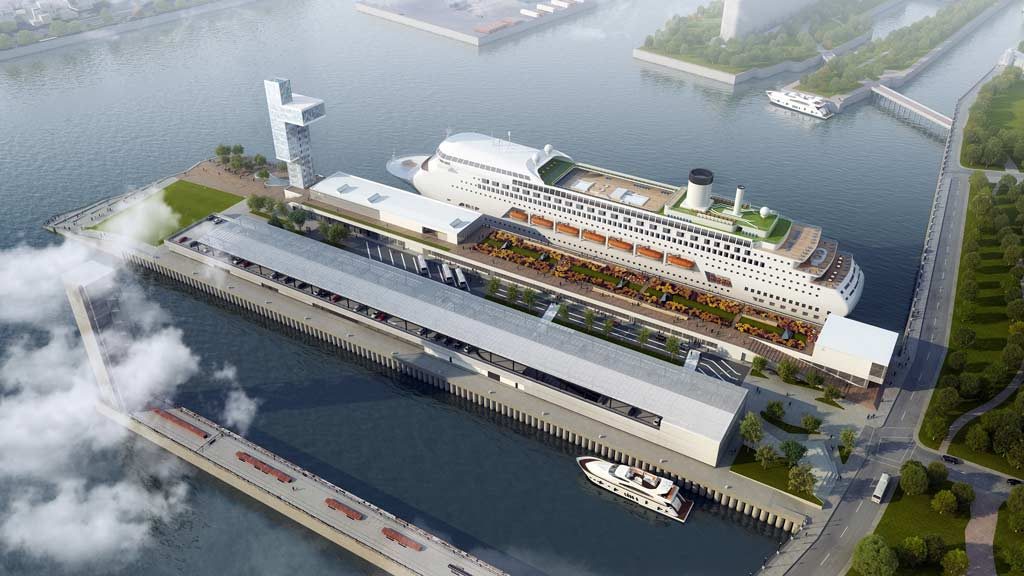The Montreal Port Authority (MPA) is poised to embark on the final stage in its ambitious, multi-year Grand Quay revitalization project with a start on construction of foundations for an observation tower.
Designed by the multidisciplinary firm of Provencher_Roy as part of an overall concept for redevelopment at the Old Port site, the tower is slated to open in 2021.
“The tower is of great relevance to us,” says Sophie Roux, vice-president, public affairs at the port authority, an autonomous federal agency. “It is an integral part of the Provencher_Roy concept.
“Reminiscent of a lighthouse, it supports the overall concept of the Grand Quay, aspiring to be a maritime signature for Montreal. It is also an additional tool to explain the port and discuss the St. Lawrence River.”
The project, which is being funded by the Government of Quebec, the City of Montreal and the Montreal Port Authority, was announced in November, 2014. Work got under way a year later.
Located on the banks of the St. Lawrence, the quay is the first point of contact with the city for cruise passengers. A new terminal opened in June 2017 as part of the project.
The concept for revitalization of the quay’s aging infrastructure was finalized following a series of public consultations and meetings with key partners and stakeholders.
Preliminary cost estimates at the start of the project were $78 million. While the final tab has not yet been determined, Roux said costs are expected to be higher than originally forecast in part because:
- The cost of stabilizing and lowering the pier turned out to be higher than initially anticipated.
- More than century-old infrastructure had to be completely renovated.
- A shore power connection for cruise ships at berth was put in place.
- An AML Cruises installation was integrated into the project.
“Furthermore, we wanted to maximize work efficiency yet we had to remain operational… throughout these project works,” Roux said.
Another issue, she said, has been a shortage of labour and subcontractors.
Currently, costs associated with construction of the “elegant” observation tower are being reassessed as the design is finalized.
“It is important to note that the MPA will assume 100 per cent of any cost variances between the preliminary concept and the final project,” Roux said.
The revitalization project was prompted in part by the need to provide a modern cruise terminal “that is in sync with current tastes and operational needs.”
The former Iberville passenger terminal, remodelled for Expo 67, was showing signs of aging and operational obsolescence.
Another factor that entered into the equation was the desire to open up the site to the general public, making it a gathering place for Montrealers and tourists alike.
Since the public opening in June of last year, pedestrians have been free to stroll along the Promenade d’Iberville, a landscaped esplanade located on the roof of the cruise terminal. It features a vast wooden terrace and thousands of flowering and aromatic plants.
Wide steps and a staircase, all in wood, have been built to grant pedestrians access to the upper pathway, made of fire-resistant red cedar.
A large wooden staircase at one end leads to Commencement Square. A work of art honouring the pioneering women who helped found Montreal will be installed in the public space.
The pedestrian path completes the Old Port’s network of public spaces and rebuilds ties between the city, the port and the river.
Roux said the project has posed some challenges for the team, which includes construction company Pomerleau. Other team members are electrical-mechanical engineering consultants Pageau Morel et associes, structural engineering consultants NCK and civil engineering and maritime infrastructure consultants WSP Group.
A major challenge, Roux said, was keeping cruise operations running while carrying out the works. A temporary terminal was put in place until the new facility opened.
“Scheduling for work completion was very tight,” Roux added. “We wanted to be able to welcome cruise passengers to the Grand Quay for Montreal’s 375th anniversary.”
The advanced age of the existing infrastructure created “several surprises,” Roux said. The Alexandra Pier, rehabilitated as part of the project, is more than 100 years old.
Carrying out the required work “quickly and efficiently” while avoiding night and weekend work represented another challenge, she said.
The current timetable for construction of the new observation tower calls for foundation construction to be completed by November with subsequent works to follow.
Roux said potential challenges include maintenance of cruise operations and access to rental and public spaces during construction as well as a tight timeline and limited access to the site for equipment.
Operated by the MPA, the port of Montreal is the second largest in Canada. It is considered one of the city’s main economic assets.











Recent Comments
comments for this post are closed